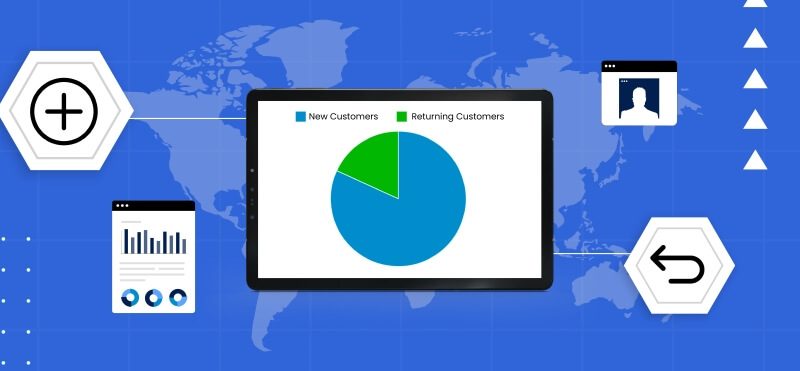As a business owner, understanding the differences between new and returning customers is paramount to driving growth and success.
While new customers represent opportunities for growth and expansion, returning customers are the backbone of your business, providing steady revenue streams and brand loyalty.
To effectively market to both types of customers, you need to understand their differences and how to use financial data to influence your marketing strategy.
Contents:
1. What is the new customers metric?
2. What is the returning customers metric?
3. Key metrics that influence your marketing direction
4. Strategies to improve new vs returning customer base
- CAC- and CLV-driven strategies
- Personalization strategies
- Customer experience-based strategies
- Increasing sales vs improving customer satisfaction and loyalty
What is the new customers metric?
New customers are those who have never purchased from your business before. New customers represent a great opportunity for growth because they are untapped potential revenue streams. However, acquiring new customers can be expensive, so make sure you are targeting the right audience and using effective marketing strategies to convert them into paying customers.
What is the returning customers metric?
On the other hand, returning customers are your most valuable customers because they have already demonstrated their loyalty to your brand by making repeat purchases. These customers provide a steady revenue stream and are more likely to make larger purchases. However, remember that returning customers also have higher expectations, so it’s crucial to maintain a high level of customer service and offer incentives to keep them returning.
Key metrics that influence your marketing direction
When it comes to using financial data to influence your marketing strategy, at our agency, we believe these key metrics must be considered.
Customer acquisition costs
First, tracking customer acquisition costs (CAC), which is the cost of acquiring a new customer, is essential. This can include marketing and advertising costs, sales commissions and other expenses. By tracking CAC, you can determine which marketing channels and campaigns are most effective at driving new customer acquisition and adjust your strategy accordingly.
Customer lifetime value
Another important metric to consider is the customer lifetime value (CLV), which is the total value of a customer throughout their relationship with your business. This includes all purchases, as well as any referrals or other contributions to your business. By calculating CLV, you can determine the value of your existing customer base and adjust your marketing strategy to maximize the lifetime value of each customer.
Retention rate
Retention rate is another key metric to consider, as it measures the percentage of customers who continue to make purchases from your business over time. A high retention rate is a strong indicator of customer loyalty and can help you identify areas where you can improve your customer experience to keep customers returning.
Strategies to improve new vs returning customer base
By analyzing these metrics, you can gain insights into your customer base and develop targeted marketing campaigns to address the needs of both new and returning customers.
CAC- and CLV-driven strategies
For example, if your CAC is high, you should focus on increasing your retention rate by offering incentives to existing customers, such as loyalty programs or referral rewards. But if your customer retention rate is strong but your CLV is low, you should focus on increasing the average order value by cross-selling or upselling to existing customers.
Personalization strategies
Another key strategy for marketing to both new and returning customers is personalization. By tailoring your marketing messages and offers to each customer’s specific needs and preferences, you can increase engagement and drive conversions. Personalization can be achieved through various tactics, such as email marketing, retargeting ads, and personalized product recommendations.
Personalization with segmenting your customers
One effective way to personalize your marketing messages is to segment your customer base based on their behavior and demographics. For example, you can segment your customers by age, location, purchase history, or browsing behavior. By tailoring your marketing messages to the specific needs and preferences of each segment, you can increase the relevance and effectiveness of your campaigns.
Personalization with dynamic content
Another effective tactic for personalization is to use dynamic content, which is content that changes based on the recipient’s behavior or preferences. For example, you may want to display different product recommendations or offers based on the recipient’s browsing history or purchase behavior. By using dynamic content, you can increase the relevance and engagement of your marketing messages.
Personalization with retargeting ads
Retargeting ads are another effective strategy for personalization, as they allow you to target customers who have already shown interest in your products or services. By displaying ads to customers who have previously visited your website or abandoned their shopping cart, you can increase the likelihood of a conversion and drive repeat purchases.
Customer experience-based strategies
In addition to personalization, focus on improving your customer experience and retention rates.
Offer incentives
One effective way to do this is to offer incentives to existing customers, such as loyalty programs, referral rewards, or exclusive discounts. You can increase retention rates and drive new customer acquisition by rewarding customers for their loyalty and referrals.
Provide exceptional customer service
Another effective strategy for improving customer experience is to provide exceptional customer service. This can include offering fast and convenient shipping, responding quickly to customer inquiries, and providing easy returns and exchanges. You can increase customer satisfaction and loyalty by providing a seamless and hassle-free customer experience.
Increasing sales vs improving customer satisfaction and loyalty
Align with your overall business goals and objectives. This means setting clear and measurable goals for your marketing campaigns and regularly tracking and analyzing your results. By monitoring key metrics such as revenue, conversion rate, and customer satisfaction, you can identify areas where you can improve your marketing strategy and achieve your business objectives.
Ensure your marketing efforts are aligned with your overall business goals and objectives. For example, if your goal is to increase revenue, you should focus on driving new customer acquisition and increasing CLV. On the other hand, if your goal is to improve customer satisfaction and loyalty, you should focus on improving your customer experience and retention rates.
Strategies: Overview
Marketing to new and returning customers requires a comprehensive strategy focusing on personalization, customer experience, and alignment with your business goals. By analyzing key financial data and developing targeted marketing campaigns, you can maximize revenue and customer satisfaction and drive growth and success for your business.
New vs returning customers: Closing thoughts
Understanding the differences between new and returning customers and using financial data to influence your marketing strategy is crucial to driving growth and success for your business.
By analyzing key metrics such as CAC, CLV, and customer retention rate, you can gain insights into your customer base and develop targeted marketing campaigns that address the needs and preferences of both new and returning customers.
By focusing on personalization, customer experience, and alignment with your business goals, you can create a comprehensive marketing strategy that maximizes revenue and customer satisfaction.






